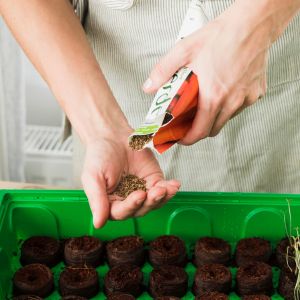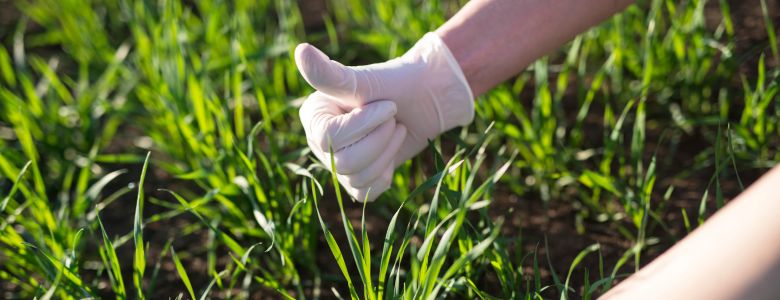Picture this: your landscape gracefully slopes down the road, a canvas waiting to be adorned with a lush carpet of green grass. However, coaxing grass to flourish on such inclines can pose quite a challenge. In this comprehensive guide, we’ll unveil the secrets of successfully planting grass seeds on slopes, turning your dream of a stunning green oasis into a vibrant reality.
Understanding the Slope

Before delving into the art of planting on slopes, let’s grasp the concept of a ‘slope.’ A slope is essentially the rise or fall of the Earth’s surface, a vital element in understanding drainage and water flow across your property.
Mathematically, slope represents the change in elevation over a given distance, indicating how the ground ascends or descends. It’s typically expressed as a percentage, such as a 12% slope, signifying a rise of 12 feet over a horizontal span of 100 feet.
Why Slope Matters
The slope plays a pivotal role in planting and maintaining your lawn for several reasons:
Safe Slope Limits: Various organizations recommend a maximum slope grade of 15% for safe planting, mowing, and maintenance. Staying within this limit ensures your landscape remains manageable.
Erosion Prevention: Planting grass seeds on slopes exceeding 15% helps prevent soil erosion, keeping your greenery intact even in challenging terrains.
Safety First: Steep slopes can be treacherous during mowing. They pose a slip hazard for walk-behind mowers and even tipping risks for ride-on mowers.
When the Slope is Too Steep
If your slope proves too perilous for regular maintenance, consider alternative landscaping approaches. Opt for low-profile plants, generally under 4 to 5 feet tall when fully grown. Terracing the slope with stone, timber, or retaining walls every 3 to 4 feet as you descend can create visually appealing tiers for planting. Select plants with robust, deep roots to control erosion, such as native Rhus aromatica. Explore low-maintenance options like native vines, junipers, and deep-rooted prairie plants.
Preparing the Slope’s Soil
- Proper soil preparation is pivotal on slopes:
- Remove existing grass, weeds, and rocks.
- Loosen the soil or add a layer of topsoil mixed with compost for a conducive seedbed.
- Slightly grade the slope’s top and bottom to reduce mower-related challenges.
- Calculate the square footage to determine seed quantity.
- Invest in high-quality grass seed suitable for your specific landscape conditions.
- Choose drought-resistant and disease-tolerant varieties, like deep-rooted grasses or Bermuda grass.
Planting on a Steep Slope (15% or More)
When sowing grass seed on a steep slope, employ a temporary dam like a 1×4 board at the hill’s top to slow rainfall and minimize soil erosion. Prior to seeding:
- Ensure the soil is moist, about 6 inches deep.
- Apply the seed as per the product instructions.
- Cross the area with a spreader for even distribution.
- Gently cover the seeds.
- Avoid walking on the seeded area.
- Lightly water the newly planted section twice a day for 10 to 15 minutes until grass establishes.
- Protect seeds with straw, cheesecloth, or burlap until grass reaches 4 to 6 inches in height.
Hydroponic Solutions for Slopes
Consider renting a hydroponic grower to expedite slope seeding. This method ensures rapid hydration of seeds, making it an efficient choice for challenging terrains.
Seed Mats or Blankets
Though pricier, seed mats or blankets offer convenience and even seed distribution. They are composed of biodegradable materials and require regular watering. These mats facilitate uniform germination and typically decompose in about 90 days.
Overseed or Slice Seeding
Machinery like over seeders and slicers can be rented for shallow grooves or ditches in the soil, improving seed-soil contact and enhancing germination.
Best Time for Planting
Fall is generally ideal for lawn planting, but if your slope remains bare, don’t delay. Weed seeds can quickly take root in exposed soil. Choose from seed blankets, mats, hydroponic systems, or slice seeding according to your preference.
Selecting the Right Grass Seed

Consult your local county extension office or home and garden centers for grass seed recommendations tailored to your area’s conditions.
When to Seek Professional Help
Maintaining a sloped lawn can be challenging, especially with steep grades. Consider enlisting the assistance of a local lawn care professional to ensure your green haven thrives.”
Note: Please ensure you follow any safety guidelines and local regulations when working on landscaping projects, especially on steep slopes.

